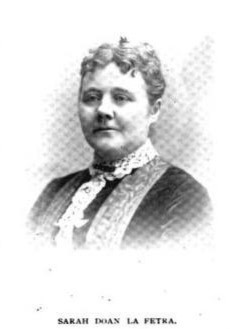June 11 - June 17
Woman of the Week
Sarah Doan La Fetra, a temperance leader from Sabina, OH, is this week's Woman of the Week.
-
To learn about her by viewing her item, please click on her image.
-
To read her biographical sketch in A Woman of the Century, please click on the highlighted page number to the left of her image.
Sarah Doan La Fetra was born in Sabina, Ohio, on June 11, 1843. After attending Alfred Holbrook's National Normal School in Ledyard, Ohio. Sarah was a teacher until her marriage to George H. La Fetra on October 6, 1867.
The La Fetra family moved to Washington, D.C., where they became members of the Metropolitan Methodist Episcopal Church, and Sarah became very active in both mission and temperance activities. She was an early member of the Woman's Christian Temperance Union of Washington, D.C., serving as its treasurer in 1881 and as its president by 1885. According to A Woman of the Century, Sarah was manager of "a temperance hotel and cafe in the very heart of the city of Washington for many years" (443). The Washington Times notes that this was Temple Cafe on F. Street, and she later managed the Hotel Fredonia on I Street. In 1894, Sarah opened Hotel La Fetra on Eleventh and G Street (Streets of Washington). Sarah was still president on February 19, 1895, when she was asked to join Frances Willard and other world and national leaders of the W.C.T.U. in presenting a polyglot petition for prohibiting "drink traffic and the opium trade" to President Cleveland at the White House (Washington Herald, November 15, 1914). In October of that year, she was named Superintendent of the new "Department of Christian Citizenship" at the World W.C.T.U.'s meeting in London. In the Ocala Evening Star of October 30, 1895, Sarah gave a detailed definition of the "Christian citizenship" she wished to promote.
Also very active in missionary work, by the first decade of the twentieth century, Sarah was a leader in the Woman's Interdenominational Mission Union. On April 4, 1912, the Baltimore branch of the Woman's Foreign Missionary Association announced plans to build the Sarah Doane La Fetra Home in Bidar, India. This mission home was named to honor Sarah, the organization's vice president (Washington Herald, April 4, 1912).
The Evening Star included a lengthy article about Mr. and Mrs. La Fetra's fiftieth wedding anniversary party, which was held on October 6, 1917. In addition to mentioning Sarah's leadership in the W.C.T.U., it noted that she "was also an originator of the work for fallen women in Washington, and has for many years been an active worker for the Hope and Help Mission, which was started by the W.C.T.U." According to the article, among those praising Sarah's work was Rosetta Lawson, "organizer of the national W.C.T.U. for colored people."
Sarah passed away on May 7, 1919. In addition to being remembered at her funeral, the W.C.T.U. honored Sarah at a memorial service. While she was no longer living, Sarah was not forgotten. According to the Evening Star of November 30, 1922, Sarah was nominated to be one of "twenty-five great women who have achieved for this community before their deaths" whose names were to be on a column of the new Temple of Womanhood building of the Women's Universal Alliance.

